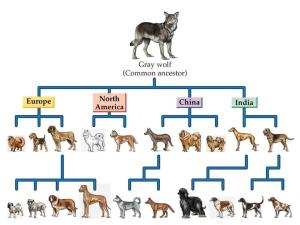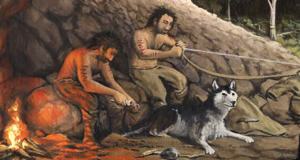“Man’s best friend” – This is how we have labeled dogs for centuries. Turns out this saying has an interesting history. Dogs are not human best friends only because they are lovely and loyal. They were also human first animal friends. Human-canine bond(the relationship between dog and human) is traced back at least 15,000 years ago and it changed the evolution of humans. Keep reading to find out how dogs became human best friend.
Most likely, the so-called “dog breeding” genes are the result of a whole complex of human genetic changes, and these changes have been an important part of human evolution. Today’s researchers call it all the modern scientific term “human self-domestication”.
“Human self-domestication”
“Human self-domestication” was a mysterious process that took place in the Paleolithic, when steppes and forests began to appear in modern Europe and Asia, after another glaciation, and when the Neanderthals and the Cro-Magnon lived side by side. Simplifying the essence of this process, it can also be said that it was at that time that humanity began to get better.
Read Also: Humanity is Degrading Rapidly. Soon We Will Reach The IQ Level of Ape.

Paleolithic humans on the campsite
The researchers state that during this time, the natural evolution was taking a full speed in human evolution. The pattern of behavior that predicted the level of intra-group aggression significantly reduced. Socially-minded people simply began to survive better. This process has been associated with a series of morphological and physiological changes that have created what we can observe today.
This new ideological view of evolutionary genetics is related to the assumption that modern man is essentially a domesticated ancient human species. According to this hypothesis, in the process of evolution, a person seems to have “self-domesticated himself.” And in any case, relationships with animals became an important part of this process.
All domesticated pets have changed
Domestication of pets is known to be associated with a number of characteristics: all domesticated pets have changed their body shape, color, and behavior to some extent. For example, a pet rabbit can get black, blue, brown, beige, and even purple fur. Also most animals that decide to form a union with humans have smaller teeth and jaws. The ears usually shrink as well, and they start to hang just like rags, while the tail often forms a circle, and so on. However, these changes are not only external.
Read Also: After 10 Years, People Will be Able to Understand Animal Language
One of the secrets of taming is related to the decrease in the size of the brain. In addition, modern research suggests that, for various reasons, domestic animals that have later become wild again retain a small brain volume of at least in the 40 next generations. This decrease is reported to occur directly in the forebrain, which regulates all body functions and interactions with the external environment. For example, the brain of a domestic pig is 35% smaller than that of a wild boar, this difference is 22% for a domesticated mink and 16% for a horse.

Evolution of dogs
Dogs also have smaller brains than wolves, but it is difficult to calculate a specific difference because of the colossal difference in the environment of countless dog breeds. However, there are two exceptions to the general rule: domesticated foxes and laboratory mice, which have not yet had to sacrifice their brain size for the sake of domestication.
The first intellectual achievement of mankind
Recently, Spanish researchers have compared modern man to Neanderthals and in the first one have found certain signs of domestication. Compared to its ancient neighbor’s Neanderthals, modern man has a much more proportionate body, the lower jaw and eyebrows are much less protruding, the teeth are also considerably smaller, and, by the way, also the brains are reduced.
If we pay attention to much deeper processes, then it becomes clear that as a result of possible “human self-domestication” the Cro-Magnon became much more socially active, his speech developed unusually fast, he showed a particularly sensitive attitude towards his brothers, and as a result, he was able to tame the wolf. Incidentally, modern researchers tend to call this fact “the first intellectual achievement of mankind.”
Read Also: Higgs Boson or particle of God – what is it in simple words?
There are a number of paleontologists who believe that the Cro-Magnon were able to displace Neanderthals precisely because of this fact. Because, in general, Neanderthals also made very complex instruments, and they had not less developed culture. They already drew on cave walls, played various musical instruments, and most likely they also had something similar to religion. But they could not tame any wild beasts …
Perhaps the initiative came from the dog
Researchers still cannot say exactly where and when the historical meeting between humans and the dog’s ancestors took place but it might happen somewhen between 10 000 to 30 000 years ago. Scientists believe that there were several places at the same time, from which domestication spread just like circular water waves. It is possible to determine more or less precise centers of the formation of such circles.

Cro-Magnon with domesticated wolf
In connection with dogs, in particular, researchers have been able to identify 14 such centers, although only two are completely confirmed today. One of them is called European, even though it is located in the so-called fertile crescent region, namely closer to the Middle East. The other – the center of the Far East, because it is located in China. There has been at least one other very serious animal domestication center in Taymyr but scientists still discuss its importance.
Read Also: 10 Biggest Catastrophic Threats to Human Existence
It is known that the dog is the first and therefore the oldest human companion. It is immediately followed by a sheep, a pig, and a cow. In addition, the researchers expressed confidence that the first dog was not domesticated accidentally, spontaneously or otherwise unknowingly.
First of all, dogs constantly improved to get closer to humans – became calmer, friendlier, and developed the ability to eat the same food as humans. They also evolved the talent to recognize and respond to human emotions, by mimicking the behavior of a young child. Today, there are a number of behavioral tests that show that people’s attachment to dogs’ emotional and neurological is similar to the attachment to children. While caring for them is comparable to typical parental behavior.
A dog has learned to imitate a person
Over the last decade, several studies have shown that the human-dog relationship is directly related to the oxytocin system. Oxytocin, on the other hand, is the hormone responsible for love, friendship, motherhood and various other forms of attachment.
A few years ago, Japanese researchers from Azabu University measured hormone levels in dogs and their owners before and after intense contact. This contact was mainly in the form of the owner and his dog looking into each other’s eyes. Looking into the eyes is an ancient manifestation of contact that is characteristic of the human species – no other animal can look into each other’s eyes for a long time, but the dog has learned to imitate a person.
 An experiment conducted by Japanese researchers has shown that when a dog looks into the owner’s eyes, the level of oxytocin in human blood increases, and as a result, he begins to show kindness and tenderness towards his four-legged friend. This in turn increases the level of oxytocin in the dog’s body, as a result of which the animal looks even more faithfully at its owner and wags its tail. Interestingly, the same interaction creates a mother’s attachment to a child.
An experiment conducted by Japanese researchers has shown that when a dog looks into the owner’s eyes, the level of oxytocin in human blood increases, and as a result, he begins to show kindness and tenderness towards his four-legged friend. This in turn increases the level of oxytocin in the dog’s body, as a result of which the animal looks even more faithfully at its owner and wags its tail. Interestingly, the same interaction creates a mother’s attachment to a child.
Although not enough research has been done in other areas. Experts already believe that a completely similar oxytocin response will most likely be seen in other animals at the highest level of domestication, mainly pigs, sheep, and cows. Even though these animals are kept mainly for the purpose of being slaughtered and eaten in the end.
Science can’t explain why humans like cats
In the case of cats, however, the situation is not so clear-cut. The domestication of this pet has lasted at least two thousand years, or thus convincingly longer than any other pet. A few years ago, one of the most prominent specialists in modern neurobiology, American Professor Paul Zak, conducted a series of experiments with oxytocin and cats. However, the reports add that the level of the oxytocin was measured only in animals and not in humans.
Read Also: 12 Things that Cat would say if could
 As a result, it was found out that after contact with the owner, the love hormone of the dog increased on average by 57%, but for most cats it did not increase at all, while for the rest it increased only by 12%. However, since the relationship between a dog and a human is built in love, there is another basis for a human relationship with a cat, which scientific methods have not yet been able to explain.
As a result, it was found out that after contact with the owner, the love hormone of the dog increased on average by 57%, but for most cats it did not increase at all, while for the rest it increased only by 12%. However, since the relationship between a dog and a human is built in love, there is another basis for a human relationship with a cat, which scientific methods have not yet been able to explain.
